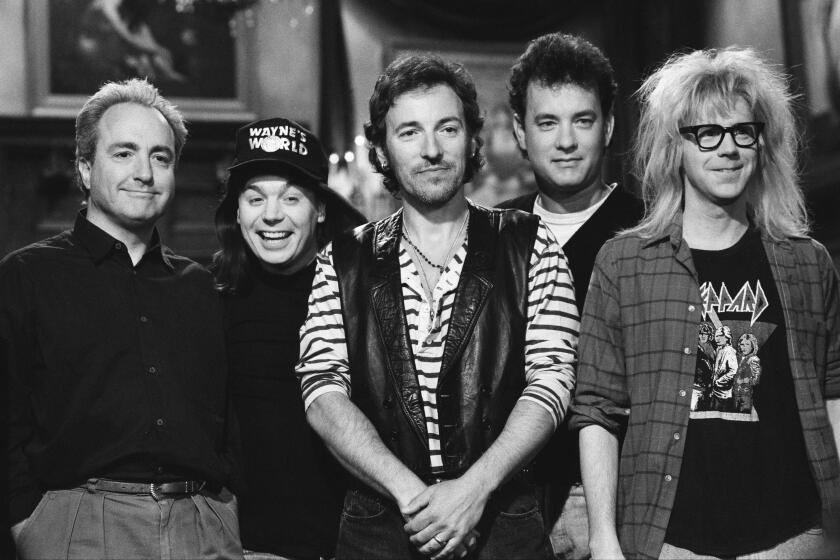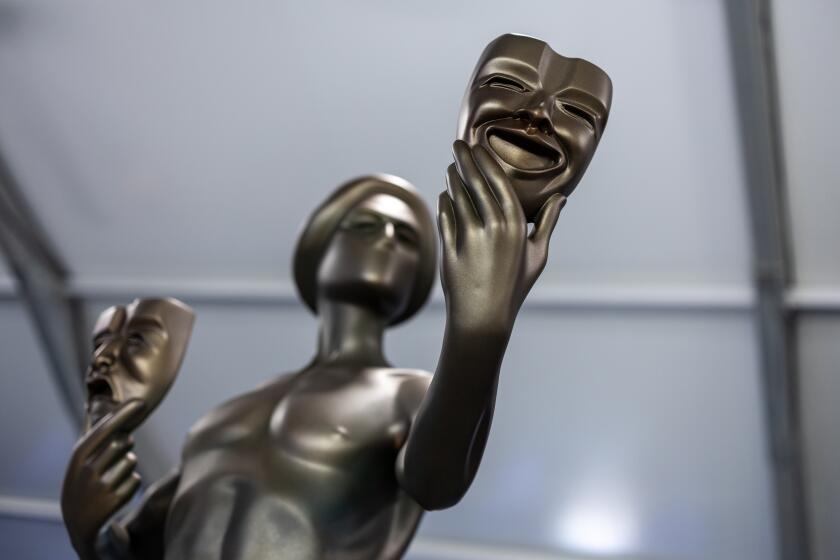Special Effects at the Height of Subtlety
- Share via
In last year’s Manifesta, the new Biennale for emerging European art held in Rotterdam, Iceland-born, Berlin-based Olafur Eliasson made time and space stand still by illuminating a fountain with strobe lights so that the drops of water seemed to freeze in midair, as hard as diamonds.
Eliasson’s trump card is his ability to conjure spectacular effects in the absence of elaborate technological paraphernalia. A certain economy--parsimony, even--is the linchpin of his aesthetic strategy. But when his poverty of means induces a poverty of effect, as in Eliasson’s current show at Marc Foxx Gallery, the results are less than gratifying.
It would be easy to miss this show entirely if you weren’t watching for clues, a ploy that’s not uninteresting when it’s a deliberate ploy--though it isn’t in this particular case. At 4 o’clock in the afternoon, the gallery looks totally empty, except for a disk of light hovering on the wall near the front door, as if inching its way out. As it turns out, the artist has cut a perfect circle in the roof of the gallery, allowing for a glimpse of sky as well as a spotlight, which travels across the wall and floor, its position determined by the time of day.
While you’re looking up, you might also notice an ordinary electric fan suspended from the ceiling. It could be the gallery’s ventilation system, but it’s not.
Motorized so that it spins in irregular circles, it is another piece by Eliasson, designed to evoke all manner of planets and orbits and to conjure predecessors like James Turrell and Robert Irwin. There is poetry in all this, and a fey charm. But there isn’t enough of either, at least not enough to merit this show.
* Marc Foxx Gallery, 3026 Nebraska Ave., Santa Monica, (310) 315-2841, through May 31. Closed Sundays and Mondays.
*
Stoic Forms: At Burnett Miller, Richard Artschwager’s new sculpture is as classically elegant as something inspired by a shipping crate ever could be. Painstakingly crafted out of pieces of pine and plywood, pressed together in sandwich-thin layers, or joined with shiny, silvery bolts, these richly allusive, geometric objects are monumentally perverse--which is to say they are stoic without being ponderous and decorative without being coy.
Each is configured differently. One rises from its base like a totem, another might look like an overturned easy chair if it weren’t the antithesis of plush, a third resembles alternately a chaise longue and a coffin.
Indeed, there is something distinctly funereal about these pieces. The latter directly recalls Magritte’s tongue-in-cheek bronze sculpture of a coffin in the reclining position of Jacques Louis David’s “Madame Recamier.”
Perhaps, though, it has something to do with the fact that however distanced the sculptures are from their sources, they still retain something of the box about them, and all the morbid associations thereof. What’s worth noting is how Artschwager gets these seemingly impassive forms to read on myriad, allegorical levels and with such deadpan wit.
The surfaces themselves, for example, are literally presented as interlocking pictures, with lengths of pale pine enframing pieces of plywood, whose patterns suddenly look quite spectacular--as much so as those in the single, weird but wonderful Celotex painting Artschwager also includes in this fine show.
* Burnett Miller Gallery, 2525 Michigan Ave., Santa Monica, through July 3. Closed Sundays and Mondays.
*
Big Whimsy: No doubt it’s irksome to constantly be labeled an eccentric, especially when you’ve been doing what you do for more than 20 years. But B. Wurtz must be used to it by now, and from the look of things at Richard Telles Gallery, there’s no way around the fact that his work breaks with conventional sculptural and pictorial idioms in odd and decidedly whimsical ways.
Low-tech to the point of no-tech, and low-key almost to the point of negligibility, Wurtz’s wall pieces are made of things like sheer plastic bags, small wooden planks, cord, nails and canvas disks, all looped, pinned, twisted or draped on, in, to or around one another. This makes things sound a bit more complicated than they are. In fact, they are simple to the point of absurdity, which is precisely their way of evoking delight.
For example, one work consists of a small piece of unprimed canvas with a white circle painted on it, in the middle of which are sewn a smattering of small buttons. It hangs on the wall from several lengths of white thread, each of which is looped around a shiny nail.
The way it’s hung is the sole drama of this piece. Elsewhere, Wurtz ekes poetry out of knots, the neatly cut edge of a piece of plastic and the curves of a bent wire.
Throwing the whole thing somewhat off balance is a free-standing assemblage, which looks something like a hugely overgrown flower, each “petal” a celestial blue plastic bag stretched over a wire armature. The piece rests on a bolt of fabric decorated with large orange dots, with a blue one smack in the center.
If you ever needed evidence that whimsy doesn’t work on an operatic scale, this is it. The best Wurtz could hope for here is a certain audacity, but what he winds up with is less than the sum of its parts.
* Richard Telles Gallery, 7380 Beverly Blvd., (213) 965-5578, through May 24. Closed Sunday and Monday.
*
Decades: The retrospective of the work of 95-year-old Dorr Bothwell at Tobey C. Moss Gallery is a rather curious one. On the one hand, it covers the 1920s to the 1950s, as opposed to the 70 years it could; on the other, it features too few of the fantastically odd Symbolist and Surrealist-influenced paintings for which this artist has achieved her small but well-deserved measure of fame.
It’s interesting to see how Bothwell wound up there. Even her earliest, Fauvist landscapes have something perverse about them.
So, too, do some of the screen-prints of the 1940s, in which, like so many of her contemporaries, she attempted to work out a synthesis between the abstract formalism of Cubism and the biomorphism of Surrealists like Miro.
Jettisoning abstraction seems to have been the key. At least it accounted for her most memorable works: a three-panel screen graced with images of a now-purring, now-pouting Siamese cat (a familiar presence in Bothwell’s paintings); a tongue-in-cheek self-portrait of the artist as a contemporary Madonna (which apparently she was not); an exquisite gouache on cardboard with a wickedly doctored photograph of a man in knee breeches planted in the middle of it; and of course, the wonderful “Family Portrait,” in which Bothwell’s younger brother, posed against a backdrop of pink so luscious it’s alarming, is sliced, literally, in two--half turn-of-the-century cherub, half malevolent wood sprite.
This 1946 painting nearly stole “Pacific Dreams,” the show of California Surrealism held at the Armand Hammer Museum in 1995. If you missed it then, here’s your second chance.
* Tobey C. Moss Gallery, 7321 Beverly Blvd., Los Angeles, (213) 933-5523, through June 21. Closed Sundays and Mondays.
More to Read
The biggest entertainment stories
Get our big stories about Hollywood, film, television, music, arts, culture and more right in your inbox as soon as they publish.
You may occasionally receive promotional content from the Los Angeles Times.










